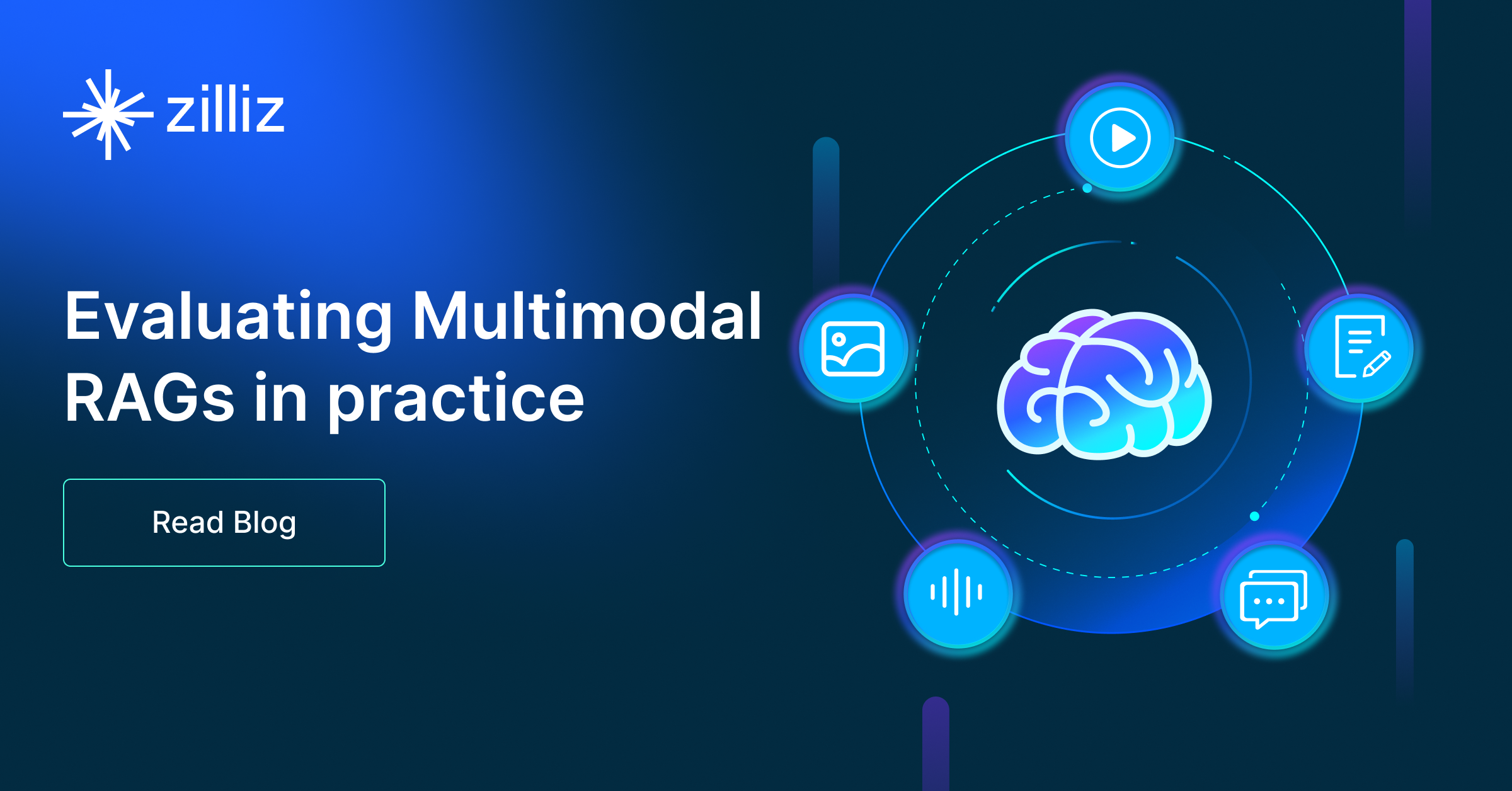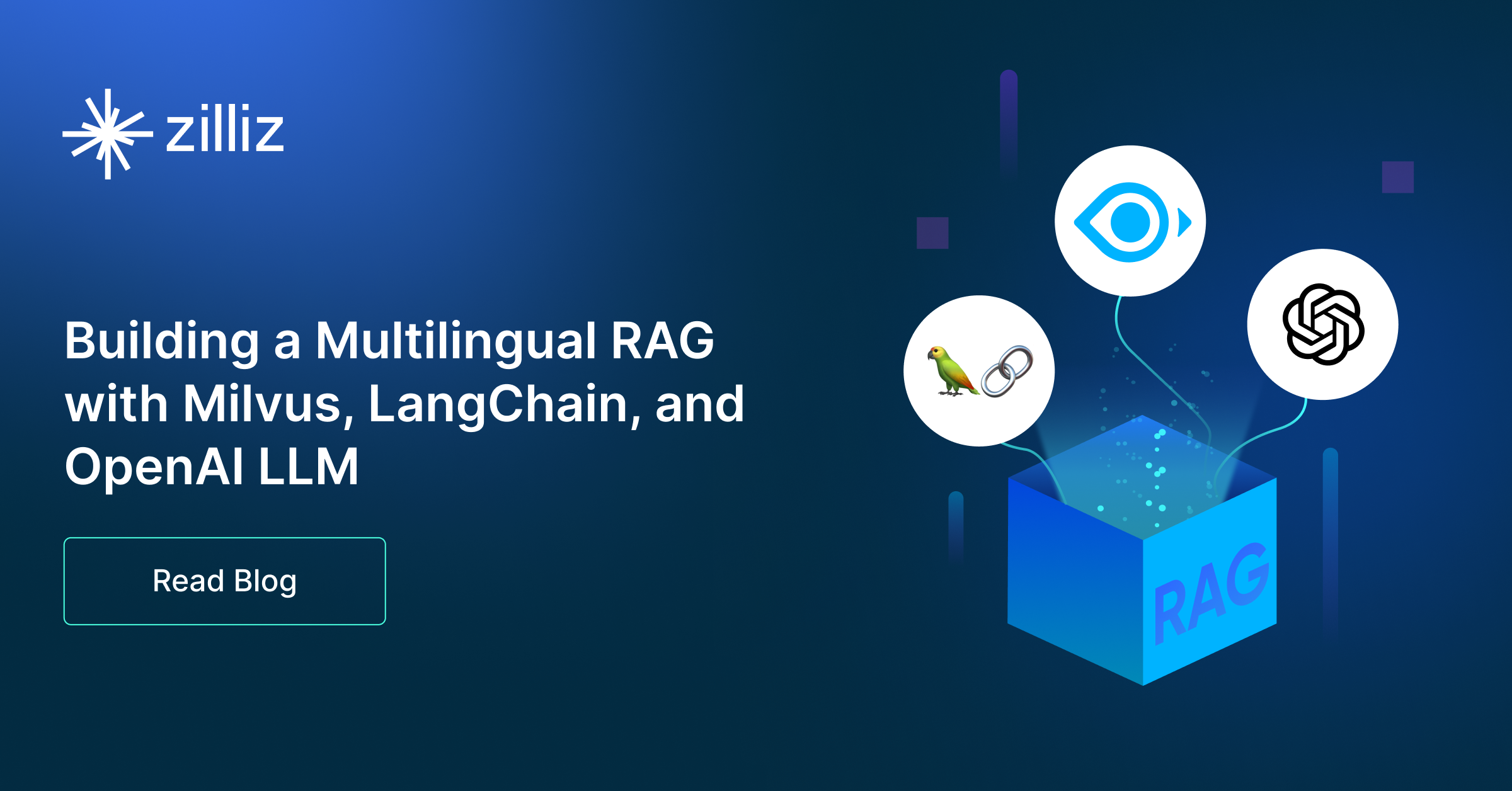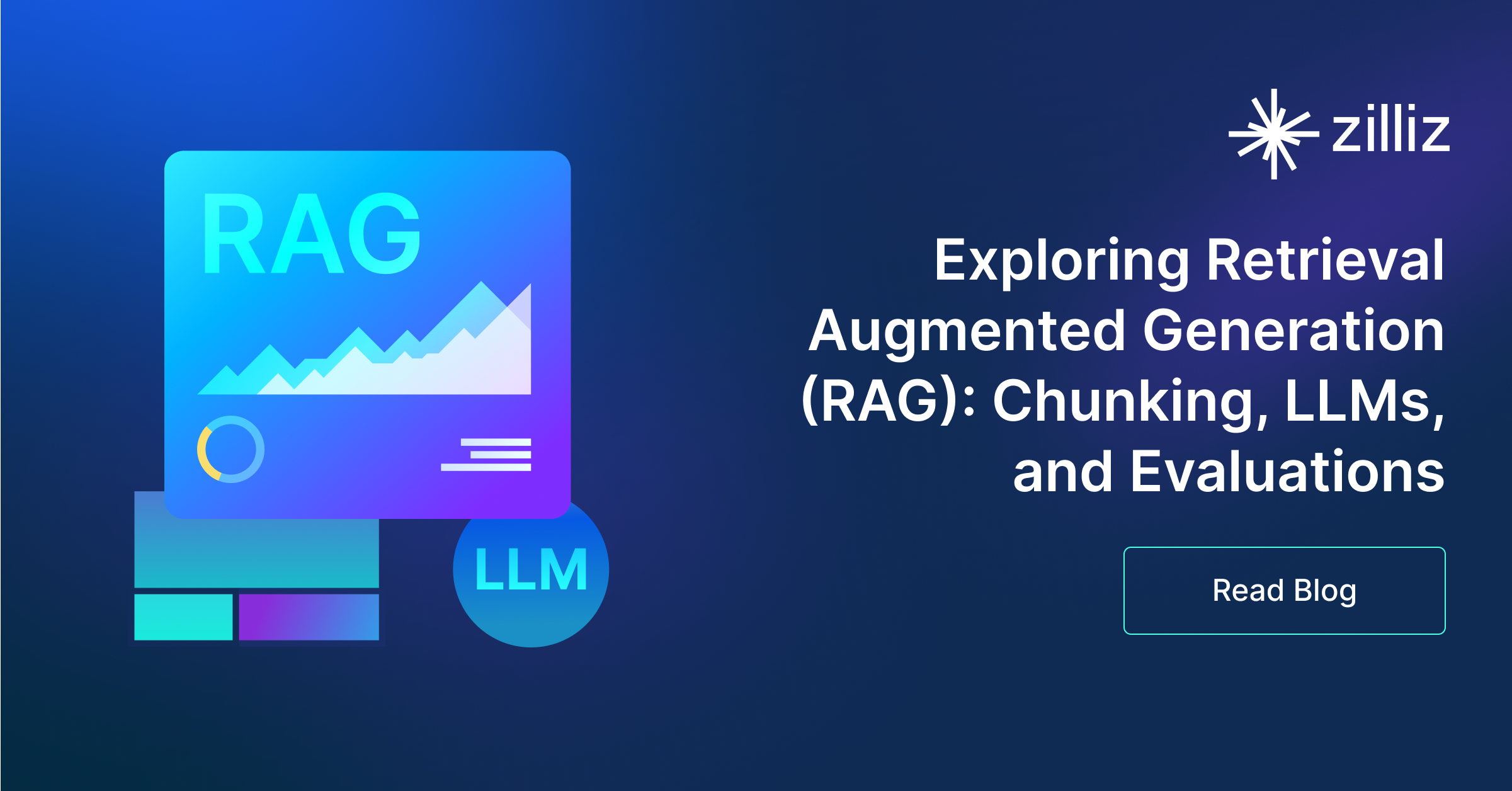Build RAG Chatbot with Llamaindex, HNSWlib, Anthropic Claude 3 Sonnet, and Cohere embed-english-light-v2.0
Introduction to RAG
Retrieval-Augmented Generation (RAG) is a game-changer for GenAI applications, especially in conversational AI. It combines the power of pre-trained large language models (LLMs) like OpenAI’s GPT with external knowledge sources stored in vector databases such as Milvus and Zilliz Cloud, allowing for more accurate, contextually relevant, and up-to-date response generation. A RAG pipeline usually consists of four basic components: a vector database, an embedding model, an LLM, and a framework.
Key Components We'll Use for This RAG Chatbot
This tutorial shows you how to build a simple RAG chatbot in Python using the following components:
- Llamaindex: a data framework that connects large language models (LLMs) with various data sources, enabling efficient retrieval-augmented generation (RAG). It helps structure, index, and query private or external data, optimizing LLM applications for search, chatbots, and analytics.
- HNSWlib: a high-performance C++ and Python library for approximate nearest neighbor (ANN) search using the Hierarchical Navigable Small World (HNSW) algorithm. It provides fast, scalable, and efficient similarity search in high-dimensional spaces, making it ideal for vector databases and AI applications.
- Anthropic Claude 3 Sonnet: A versatile AI model optimized for complex reasoning, multilingual tasks, and processing long-context inputs. It balances high performance with cost-efficiency, ideal for enterprise-scale applications like data analysis, real-time customer support, content creation, and research tasks requiring accuracy and scalability across diverse industries.
- Cohere embed-english-light-v2.0: A lightweight embedding model optimized to convert English text into dense vector representations efficiently. It excels in semantic search, clustering, and similarity tasks, balancing speed and accuracy. Ideal for real-time applications, cost-sensitive deployments, and resource-constrained environments requiring scalable, rapid text analysis without compromising performance.
By the end of this tutorial, you’ll have a functional chatbot capable of answering questions based on a custom knowledge base.
Note: Since we may use proprietary models in our tutorials, make sure you have the required API key beforehand.
Step 1: Install and Set Up Llamaindex
pip install llama-index
Step 2: Install and Set Up Anthropic Claude 3 Sonnet
%pip install llama-index-llms-anthropic
from llama_index.llms.anthropic import Anthropic
# To customize your API key, do this
# otherwise it will lookup ANTHROPIC_API_KEY from your env variable
# llm = Anthropic(api_key="")
llm = Anthropic(model="claude-3-sonnet-20240229")
Step 3: Install and Set Up Cohere embed-english-light-v2.0
%pip install llama-index-embeddings-cohere
from llama_index.embeddings.cohere import CohereEmbedding
embed_model = CohereEmbedding(
api_key=cohere_api_key,
model_name="embed-english-light-v2.0",
)
Step 4: Install and Set Up HNSWlib
%pip install llama-index-vector-stores-hnswlib
from llama_index.vector_stores.hnswlib import HnswlibVectorStore
from llama_index.core import (
VectorStoreIndex,
StorageContext,
SimpleDirectoryReader,
)
vector_store = HnswlibVectorStore.from_params(
space="ip",
dimension=embed_model._model.get_sentence_embedding_dimension(),
max_elements=1000,
)
Step 5: Build a RAG Chatbot
Now that you’ve set up all components, let’s start to build a simple chatbot. We’ll use the Milvus introduction doc as a private knowledge base. You can replace it with your own dataset to customize your RAG chatbot.
import requests
from llama_index.core import SimpleDirectoryReader
# load documents
url = 'https://raw.githubusercontent.com/milvus-io/milvus-docs/refs/heads/v2.5.x/site/en/about/overview.md'
example_file = 'example_file.md' # You can replace it with your own file paths.
response = requests.get(url)
with open(example_file, 'wb') as f:
f.write(response.content)
documents = SimpleDirectoryReader(
input_files=[example_file]
).load_data()
print("Document ID:", documents[0].doc_id)
storage_context = StorageContext.from_defaults(vector_store=vector_store)
index = VectorStoreIndex.from_documents(
documents, storage_context=storage_context, embed_model=embed_model
)
query_engine = index.as_query_engine(llm=llm)
res = query_engine.query("What is Milvus?") # You can replace it with your own question.
print(res)
Example output
Milvus is a high-performance, highly scalable vector database designed to operate efficiently across various environments, from personal laptops to large-scale distributed systems. It is available as both open-source software and a cloud service. Milvus excels in managing unstructured data by converting it into numerical vectors through embeddings, which facilitates fast and scalable searches and analytics. The database supports a wide range of data types and offers robust data modeling capabilities, allowing users to organize their data effectively. Additionally, Milvus provides multiple deployment options, including a lightweight version for quick prototyping and a distributed version for handling massive data scales.
Optimization Tips
As you build your RAG system, optimization is key to ensuring peak performance and efficiency. While setting up the components is an essential first step, fine-tuning each one will help you create a solution that works even better and scales seamlessly. In this section, we’ll share some practical tips for optimizing all these components, giving you the edge to build smarter, faster, and more responsive RAG applications.
LlamaIndex optimization tips
To optimize LlamaIndex for a Retrieval-Augmented Generation (RAG) setup, structure your data efficiently using hierarchical indices like tree-based or keyword-table indices for faster retrieval. Use embeddings that align with your use case to improve search relevance. Fine-tune chunk sizes to balance context length and retrieval precision. Enable caching for frequently accessed queries to enhance performance. Optimize metadata filtering to reduce unnecessary search space and improve speed. If using vector databases, ensure indexing strategies align with your query patterns. Implement async processing to handle large-scale document ingestion efficiently. Regularly monitor query performance and adjust indexing parameters as needed for optimal results.
HNSWlib optimization tips
To optimize HNSWlib for a Retrieval-Augmented Generation (RAG) setup, fine-tune the M parameter (number of connections per node) to balance accuracy and memory usage—higher values improve recall but increase indexing time. Adjust ef_construction (search depth during indexing) to enhance retrieval quality. During queries, set ef_search dynamically based on latency vs. accuracy trade-offs. Use multi-threading for faster indexing and querying. Ensure vectors are properly normalized for consistent similarity comparisons. If working with large datasets, periodically rebuild the index to maintain efficiency. Store the index on disk and load it efficiently for persistence in production environments. Monitor query performance and tweak parameters to achieve optimal speed-recall balance.
Anthropic Claude 3 Sonnet optimization tips
To optimize Claude 3 Sonnet in RAG workflows, refine retrieval chunk sizes to balance context relevance and token efficiency—aim for 500-800 token chunks with 15% overlap. Use structured prompts with XML tags or markdown to separate instructions from retrieved content, explicitly directing Claude to ground responses in provided sources. Lower temperature (0.2-0.4) improves factual consistency, while adding validation steps like “Verify this answer is fully supported by the context” reduces hallucinations. Prioritize system prompts to define response formats and enforce source citation. Test top-p (0.7-0.9) and max tokens to control output breadth without truncation.
Cohere embed-english-light-v2.0 optimization tips
To optimize Cohere embed-english-light-v2.0 in RAG, preprocess input text by truncating or chunking documents to the model’s 512-token limit for efficiency. Use batch processing to encode multiple texts simultaneously, reducing API overhead. Normalize embeddings to improve cosine similarity accuracy. Pair with a fast vector database (e.g., FAISS) for low-latency retrieval. Cache frequent queries to minimize redundant computations. Monitor embedding quality via retrieval hit rates and adjust text chunking strategies for domain-specific contexts. Fine-tune batch sizes to balance speed and memory usage.
By implementing these tips across your components, you'll be able to enhance the performance and functionality of your RAG system, ensuring it’s optimized for both speed and accuracy. Keep testing, iterating, and refining your setup to stay ahead in the ever-evolving world of AI development.
RAG Cost Calculator: A Free Tool to Calculate Your Cost in Seconds
Estimating the cost of a Retrieval-Augmented Generation (RAG) pipeline involves analyzing expenses across vector storage, compute resources, and API usage. Key cost drivers include vector database queries, embedding generation, and LLM inference.
RAG Cost Calculator is a free tool that quickly estimates the cost of building a RAG pipeline, including chunking, embedding, vector storage/search, and LLM generation. It also helps you identify cost-saving opportunities and achieve up to 10x cost reduction on vector databases with the serverless option.
 Calculate your RAG cost
Calculate your RAG cost
What Have You Learned?
Congratulations on making it through the tutorial! You’ve just unlocked a wealth of knowledge about building a Retrieval-Augmented Generation (RAG) system, and it’s fantastic to see how much you’ve learned about integrating various components. By leveraging the LlamaIndex framework for your data management, the HNSWlib vector database for efficient nearest neighbor searches, the powerful Anthropic Claude 3 Sonnet LLM for generating responses, and the Cohere embed-english-light-v2.0 model for top-notch embeddings, you’ve pieced together a robust pipeline that enhances the capabilities of traditional language models. Each component plays a pivotal role: LlamaIndex organizes your data seamlessly, HNSWlib accelerates the retrieval process, and the combined strength of Anthropic and Cohere brings your RAG system to life with high-quality outputs.
But remember, this is just the beginning! The tutorial also provided optimization tips to enhance your system’s performance and even included a handy free RAG cost calculator to help you stay on budget. Imagine the endless possibilities now that you have the foundational skills to build your applications! So, don’t hesitate—dive in, experiment, and start creating innovative RAG solutions tailored to your needs. Embrace the journey of building and optimizing, and who knows? Your next project could be the breakthrough that enhances the world of AI. Get started today, and let your creativity flow!
Further Resources
🌟 In addition to this RAG tutorial, unleash your full potential with these incredible resources to level up your RAG skills.
- How to Build a Multimodal RAG | Documentation
- How to Enhance the Performance of Your RAG Pipeline
- Graph RAG with Milvus | Documentation
- How to Evaluate RAG Applications - Zilliz Learn
- Generative AI Resource Hub | Zilliz
We'd Love to Hear What You Think!
We’d love to hear your thoughts! 🌟 Leave your questions or comments below or join our vibrant Milvus Discord community to share your experiences, ask questions, or connect with thousands of AI enthusiasts. Your journey matters to us!
If you like this tutorial, show your support by giving our Milvus GitHub repo a star ⭐—it means the world to us and inspires us to keep creating! 💖
- Introduction to RAG
- Key Components We'll Use for This RAG Chatbot
- Step 1: Install and Set Up Llamaindex
- Step 2: Install and Set Up Anthropic Claude 3 Sonnet
- Step 3: Install and Set Up Cohere embed-english-light-v2.0
- Step 4: Install and Set Up HNSWlib
- Step 5: Build a RAG Chatbot
- Optimization Tips
- RAG Cost Calculator: A Free Tool to Calculate Your Cost in Seconds
- What Have You Learned?
- Further Resources
- We'd Love to Hear What You Think!
Content
Vector Database at Scale
Zilliz Cloud is a fully-managed vector database built for scale, perfect for your RAG apps.
Try Zilliz Cloud for Free


